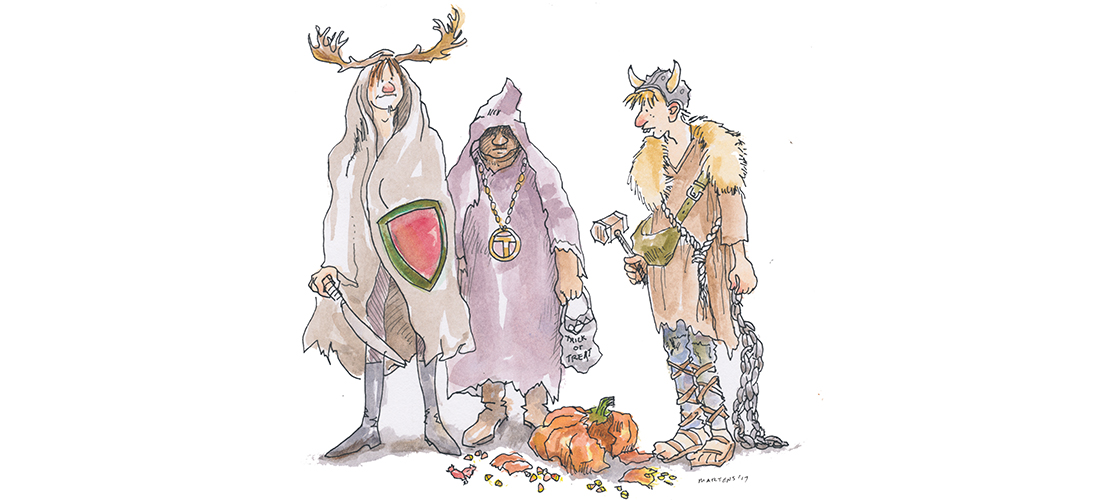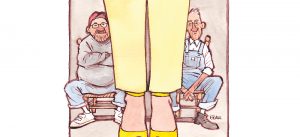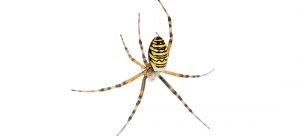
Celebrating Samhain with the Bordens
From ghoulies and ghosties and long-leggity teenagers in Mr. T costumes, oh Lord, please deliver us
By Jane Borden
On October 31 — the night between summer and winter, the midpoint between the autumnal equinox and winter solstice — the barrier between the realms of the living and the dead grows thin and flimsy. Spirits sneak through.
Or so believed the Celts and their Druid priest class, who lived more than 2,000 years ago in what is now Ireland, northern France and the U.K. To appease the spirits, and secure health and safety through the coming winter, the Celts celebrated the festival of Samhain. Eventually, Samhain traveled through the lenses of the Romans, the Catholic Church, and the American consumer, and became Halloween.
Based on my childhood memories of Halloween in the 1980s, though, Samhain is still alive and well in Greensboro. Here are five eery similarities between my family’s celebrations and those of the ancient Celts. Either nothing ever really changes, or my parents were Druids. You decide.
CROP DESTRUCTION
Spirits are tricksy. The Celts believed that the dead crossed into the realm of the living with a purpose: to wreak havoc on crops.
One year, my dad grew pumpkins in our backyard. Rather, he grew pumpkin. His crop yielded one, which we carved in time for Halloween. But when we rose on November 1 — hours after the spirits returned to their world and the barrier closed again — we found our pumpkin in pieces, smashed and left on the sidewalk. My eldest sister, Lou, cried. But Dad was like, “Well, it’s a pumpkin.” Spoken like a man accustomed to giving the dead their due.
APPEASING THE SPIRITS
These other-world residents not only destroyed crops, according to the Celts, but came to engage in all manner of nefarious shenanigans. As an insurance policy for themselves and their belongings, Celts tried to keep the spirits happy.
I remember seeing some marauding specters firsthand. They terrorized Country Club Drive, moving on foot in small groups. Fearsome were their Tretorn sneakers and homemade Mr T costumes! Lo, how they sprayed shaving cream on foliage! My gods, what happens to boys in puberty?!
One year, a group of these teen ghosts chased us on the golf course. They bullied many children that year — and even stole trick-or-treating candy. There is no greater sin than taking candy from a child princess. Only an evil spirit (or adolescent male) could execute such an atrocity. Mom was prepared to call the cops. But then one of the victims recognized one of the perpetrators, a football player at Aycock, at which point we begged Mom not to turn them in. Come to think of it, maybe instead of a Celtic community, I just grew up in a patriarchy.
AVOIDING POSSESSION
Another way to keep spirits out of your body: disguises. The Celts wore costumes on Samhain to throw off the spirits. Some historical accounts depict the Celts in animal skins and furs. Others have the Celts wearing white and painting their faces black.
My sisters and I often wore the same costumes, as a result of their being handed down. We especially remember a little Dutch girl costume, which had been brought home from a visit to Holland by my mom’s uncle Britt. It was worn not only by my sisters and me, but also by my mom and her sister. I now realize how dangerous this was. What ghost would see a Dutch girl five times — in Greensboro, N.C. — and not recognize her? And not think, “Huh, that Dutch girl hasn’t aged in 35 years. I better check it out by possessing her.” Being dead doesn’t make you dumb.
PREDICTING THE FUTURE
Divination was among the Druids’ primary jobs. The priests were especially busy on Samhain. Celts believed the future could be more easily accessed on the night the living mingled with the dead. On Samhain, even regular Celts went around telling each other’s fortunes, as part of the fun.
Similarly, one of my family’s friends made a keen prediction one Halloween night. Every year, Dad took us on the same trick-or-treating tour, stopping by the homes of a handful of family members and friends, including that of Louise Miller, my preschool teacher (and my sisters’) at First Presbyterian Church.
One year, Mrs. Miller pulled up in a taxi just as we arrived. My parents can’t remember the details exactly. She suddenly realized that she’d either left her pocketbook at the airport or at the hospital. Regardless, she didn’t have keys to her apartment or a wallet, and upon realizing as much, had directed the driver to continue taking her home anyway. So Dad paid the driver and drove Louise to retrieve her purse. My sister Tucker remembers that when Louise got out of the taxi, she said to Dad, “I told the driver you’d be here, you always come.” Dad paid the driver and drove Louise to retrieve her purse.
SACRIFICES
Whether to appease the gods or the spirits, ritual sacrifices were a common Celtic practice. On Samhain, the Druids burned crops. During war, they slashed throats and, some believe, cannibalized the victims ceremoniously. Anything would be given over, if it made the gods happy.
Similarly, most of our Halloween candy mysteriously disappeared every November 2nd. But in our case, the gods lived in a trashcan. So, maybe my parents weren’t Druids after all. Maybe they just worshipped raccoons. OH
Jane Borden now lives in Los Angeles, where, hopefully, her daughter will wear the Dutch girl costume on a Halloween soon.





